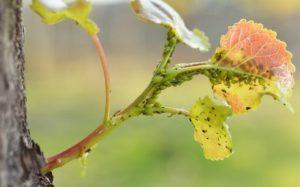Aphids - a small pest of the whole garden: acquaintance
In the garden and vegetable garden, harmful insects often make up the company of cultivated plants. They harm vegetable and fruit crops, as well as many trees. One of these insects is aphids.
Content
What aphid looks like: photo
Description of the insect
Name: subfamily Aphids
Latin:AphidoideaClass: Insects - Insecta
Squad: Hemiptera - Hemiptera
 | Habitats: | everywhere |
 | Features: | small insect colonies |
 | Harm: | representatives of the species feed on plant sap, can completely destroy |
Aphids are one of the most common types of parasites - insects. In total there are more than 3500 varieties. Insects unite in huge colonies, occupying all garden and indoor plants.
The danger of aphids lies in the sucking out of juices and the transmission of viruses to plants.
Features of the structure of the body
The shape of the body is affected by the type of insect. But there are general parameters that most insects correspond to.
The shape of the body can be in the form of: an ellipse, a hemisphere, a drop, an egg, an oval. The size varies between 0,3 - 0,8 mm. The body is transparent and soft. The color of the pest matches the color of the plant on which it lives. On the body there are tubercles, outgrowths, fluff, hairs.
The head is trapezoid with antennae. They have organs of hearing and touch. The main difference from other insects is excellent vision. The eyes are multifaceted. They are usually red, brown or black.
The oral apparatus is referred to as the sucking type. With its help, parasites pierce the surface tissue of the plant and get to the juice. Some individuals have long and sharp proboscises, the rest have short and blunt ones.
The shape of the chest is influenced by wings and stage of development. An insect can be not only winged, but also wingless. The jumping function is performed by thin and long legs.
The belly consists of 9 parts. First 7 segments with spiracles. The rest are equipped with juice tubes that have a secretory and excretory function. The last underdeveloped segment has a hairy tail.
Habitat
Insects prefer areas with a warm and humid climate. The climate contributes to the removal of the greatest number of generations during the season. Aphid lives in vast territories, ranging from Siberia to Western Europe.
Sharp temperature changes, drought and heavy rains prevent reproduction.
Aphid diet
The insect feeds on the underside of leaves, stems, buds, flowers, tops of young shoots.
Favorite treat - vegetable juicewhich contains amino acids and carbohydrates. Pests secrete a sweet liquid that ants love. For this reason, ants surround the aphid colony.
Life cycle
Common types
It is worth noting that about 1000 varieties live on the European continent. Among the most popular, there are several of the most common types.
| leaf gall | Damages white, black, red currants. |
| Beet or bean | It feeds on beets, potatoes, legumes, poppy seeds, jasmine, viburnum, sunflower stems and leaves. |
| Cucumber or gourd | It harms watermelon, melon, pumpkin, cucumber, tobacco, peanut, sesame, beet, citrus, eucalyptus. |
| cabbage | Uses radish, radish, cabbage. |
| Grape | Eats only grapes. |
| Carrot | Destroys carrots and umbrella plants |
| Aphids on roses | The diet consists of roses, rose hips, pears, apple trees, strawberries. |
| Green apple | It feeds on apple, pear, cotoneaster, medlar, shadberry, quince, mountain ash, hawthorn |
| Large potato | The diet includes potatoes, beets, cabbage, tomatoes, greenhouse and indoor plants. |
| big peach | Eats peach, almond, cherry plum, plum, apricot, walnut trees. |
| peach aphid | It feeds on plum, peach, cherry plum, tobacco, cabbage, potatoes, eggplant, pepper, radish, dill, cucumber, parsley, lettuce, greenhouse crops. |
| hairy | Damages indoor and greenhouse plants, citrus fruits, grapes. |
| Room | Not picky about diet. |
Harm from aphids
Aphids can be confidently called the most dangerous pest.
Insects feed on the vital juice of roots and shoots. For this reason, fruiting is reduced. Sometimes trees, shrubs, vegetable crops die completely.
However, there are effective pest control methods.
Methods of struggle
Standard methods for dealing with aphids on the site consist of a number of procedures.
- Cleaning the trunk circle.
- Removal of ants from the site.
- Physical cleaning of damaged parts.
All methods can be conditionally divided into folk, biological, physical or chemical.
Meet and choose effective method of removing aphids from the site among 26 possible in this article.
Preventive measures
To prevent the appearance of aphids on fruit trees and crops, a number of simple requirements must be observed. The first and basic rule is that a healthy garden does not suffer from pests.
- In autumn, clean the area from debris and carrion.
- In the spring, prune and spray.
- Whiten trees twice a season.
- Remove anthills and trails.
- Feed, but do not exaggerate the amount of nitrogen.
An interesting fact: the Iranians make an alcoholic decoction based on an insect, similar in its properties to aphrodisiacs.
Conclusion
Aphids are a frequent visitor to a weakened area. But with proper care, getting rid of the pest will not be a problem. If small insects have already penetrated, you should choose a simple way to fight.
